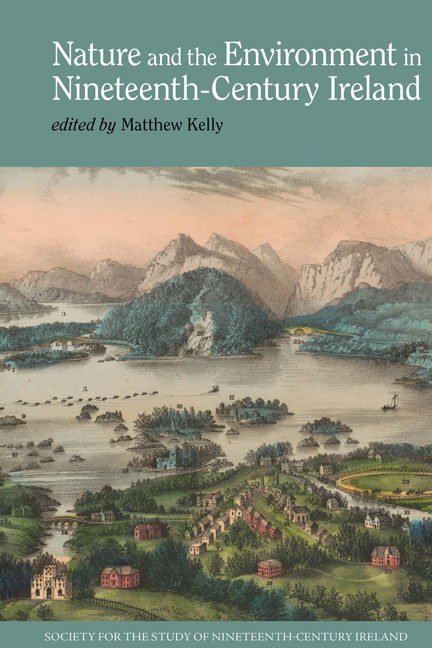Book contents
- Frontmatter
- Contents
- Acknowledgements
- List of Figures
- List of Tables
- List of Contributors
- Introduction
- 1 The Nature of Improvement in Ireland
- 2 Palmerston’s Conquest of Sligo
- 3 ‘A Voice for Ireland’: Isaac Butt, Environmental Justice, and the Dilemmas of the Irish Land Question
- 4 ‘In the Open Country’: Nature and the Environment during the ‘Monster’ Meeting Campaign of 1843
- 5 Therapeutic Environments in Nineteenth-Century Ireland: Hybrid Spaces and Practices
- 6 On Why the UK’s First National Park Might Have Been in Ireland
- 7 Towards an Environmental History of Nineteenth-Century Dublin
- 8 Mainstream or Tributary? The Question of ‘Hibernian’ Fishes in William Thompson’s The Natural History of Ireland (1849–56)
- 9 The Ocean of Truth: Atlantic Imagery in Emily Lawless’s Major Lawrence, F.L.S. (1885) and Grania: The Story of an Island (1892)
- 10 Seumas O’Sullivan and Revivalist Nature Poetry
- Index
7 - Towards an Environmental History of Nineteenth-Century Dublin
- Frontmatter
- Contents
- Acknowledgements
- List of Figures
- List of Tables
- List of Contributors
- Introduction
- 1 The Nature of Improvement in Ireland
- 2 Palmerston’s Conquest of Sligo
- 3 ‘A Voice for Ireland’: Isaac Butt, Environmental Justice, and the Dilemmas of the Irish Land Question
- 4 ‘In the Open Country’: Nature and the Environment during the ‘Monster’ Meeting Campaign of 1843
- 5 Therapeutic Environments in Nineteenth-Century Ireland: Hybrid Spaces and Practices
- 6 On Why the UK’s First National Park Might Have Been in Ireland
- 7 Towards an Environmental History of Nineteenth-Century Dublin
- 8 Mainstream or Tributary? The Question of ‘Hibernian’ Fishes in William Thompson’s The Natural History of Ireland (1849–56)
- 9 The Ocean of Truth: Atlantic Imagery in Emily Lawless’s Major Lawrence, F.L.S. (1885) and Grania: The Story of an Island (1892)
- 10 Seumas O’Sullivan and Revivalist Nature Poetry
- Index
Summary
What would an environmental history of Dublin look like? Why would we need such a history? Environmental history, which has its roots in the American conservation movement of the 1960s, originally focused its attention on rural landscapes and the frontiers of human settlement. Now that few places on earth could be considered untouched by human activity, a more expansive idea of environmental history has emerged to encompass a wide variety of interactions between the human and non-human worlds. Urban environmental historians have seen cities not as exclusively human places, but spaces in which humans are in constant negotiation with the non-human world. The following pages begin to map some directions for an environmental history of nineteenth-century Dublin. First, I show how we might examine the intersection between environmental factors and socioeconomic change to understand the distribution of people and businesses in the city. Second, I look at animal businesses in detail to see how changes to the use of animals in the city both reflected and shaped larger processes of change in Dublin over the Victorian period.
Urban Landscapes
The nineteenth century was a transitional period for the shape and size of most cities in Europe and America. Industrial cities expanded rapidly in area, population, and infrastructure. Manchester, Leeds, and Glasgow are often cited for their dramatic and, to contemporary observers, unnnerving population explosions. The majority of these cities’ new residents were poor, unskilled workers and their arrival coincided with the increasing flight from the city centre of the middle and upper classes who sought the healthier, cleaner environments of the suburbs. Movements of population created rings of differing social and economic status around the city centre, leaving the inner core increasingly impoverished and often polluted. Despite the interest of municipal authorities in controlling nuisances from industries and noxious trades, many factories remained in the city centre throughout the century. Among the trades that produced unpleasant smells and effluvia were a wide variety of animal businesses, including slaughterhouses, dairies, bacon factories, bone boilers, glue manufactories, tanners, skinners, and tallow chandlers. Thus the urban poor and the city's non-human residents were often left to share the same insalubrious space.
Despite Dublin's failure to develop a manufacturing economy, the city shared the socio-economic and geographical transitions that marked many industrializing cities.
- Type
- Chapter
- Information
- Nature and the Environment in Nineteenth-Century Ireland , pp. 139 - 158Publisher: Liverpool University PressPrint publication year: 2019

